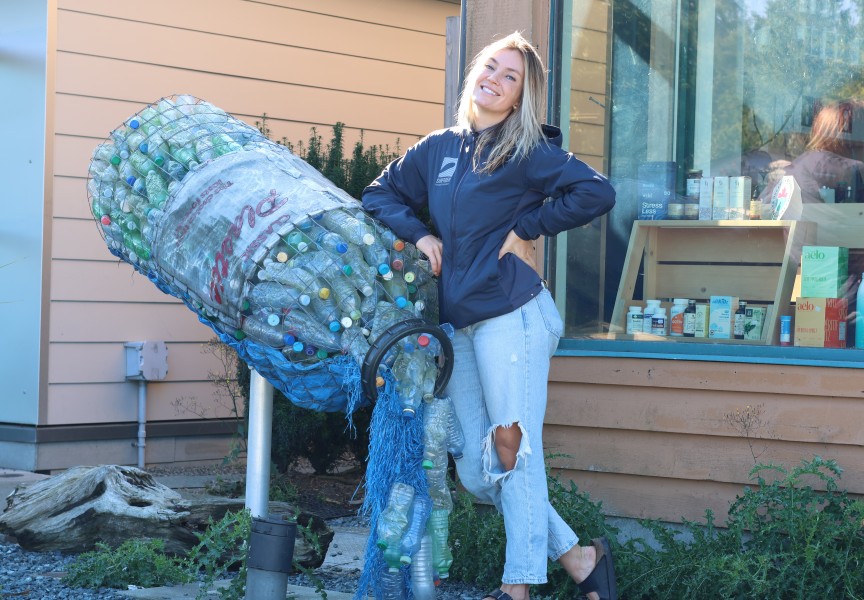On July 22 an entangled humpback whale was reported to be seen off the coast of Leonard Lighthouse, near Tofino.
Since the initial sighting Fisheries and Oceans Canada, alongside Strawberry Isle Marine Research Society (SIMRS), have struggled to relocate the humpback and encourage community members to call the DFO marine mammal incident reporting hotline if seen, while remaining 200 meters away.
On Sunday, the day after the initial sighting, they were able to relocate the humpback whale. But by the time specialized professionals and gear arrived they had lost the whale once again, said SIMRS Executive Director Karyssa Arnett, who has been out searching with DFO.
“Humpback whales are more prone to entanglements and vessel strikes,” said Arnett. “They have a really sporadic moving behavior.”
“They might pop up one place and then they might come up at a completely different spot the next time you see them, so that’s what makes them hard to track while you’re watching them,” she added.
Although Strawberry Isle Marine Research, Parks Canada and fisheries officers in the Tofino region are trained to respond to whale entanglements by placing a satellite tracker on the gear attached to the whale, only DFO has a specialized and trained unit to remove the entanglement.
Arnett said that as DFO continues to search for the entangled humpback whale, it is important that fishers, private boaters, and the whale watching community keep a lookout. She said that when spotted it’s important that people call the marine mammal incident reporting hotline as soon as possible, while keeping eyes on the whale at a distance of 200 meters away until other boats arrive.
“It takes a lot of effort and takes a lot of eyes to keep track of these things,” she said.
Arnett said that it’s very important that people do not attempt to disentangle the whale, noting that it is a safety concern for people and can cause harm to the whale.
With this whale, it’s towing two floats. Arnett said that it is assumed that the lines are tangled around the tail but due to low visibility from the boat, the equipment could also be tangled elsewhere.
“There might be some more not-visible rope, maybe entangled around the pectoral flippers or through the mouth or something, too,” said Arnett. “That's why it's really important for the professionals to go out there with the proper equipment and training.”
“The highest risk for [the entangled whale] is [that] it usually leads to difficulty in feeding,” she said. “Either the float or the entanglement is slowing them down, making it harder to dive and feed.”
“Typically, with these cases, the whale slowly starves to death, essentially - if the entanglement isn't removed,” said Arnett.
While some humpback whales migrate through Nuu-chah-nulth waters to Alaska, a small subset remain along the B.C. coast for the summer, she said.
Arnett explained that they come from Hawaii, Mexico, and Costa Rica in early spring, and return south in the fall.
“They’re primarily just trying to feed while they’re coming up the coast,” said Arnett.
She said that the number of humpback whales migrating along the B.C. coast is in the thousands and continue to grow.
“They’re actually coming on quite a big population rebound,” she said. “In the early days they were hunted through whaling.”
Joe Martin, Tla-o-qui-aht master carver, told Ha-Shilth-Sa about the whale hunting village of Echachisht, located near Tofino. Martin has been going to the island where Echachisht is located ever since he was young.
“[I] noticed a lot of whale bones out there,” said Martin.
Alongside whale biologist Jim Darling, Martin took samples of the whale bones that lay accessible on the surface of the ground, with permission from Tla-o-qui-aht.
“We collected hundreds of samples,” he said, adding that they were sent to Florida for DNA testing.
“It turns out that there were five species of whales that were caught and brought there to Echachisht,” said Martin, noting that the bones found belonged to the humpback whale, gray whale, sperm whale, fin whale, and right whale.
The oldest whale bone that was sampled was 1,000 years old, he said.
“At most of our village sites, you will find those whale bones,” said Martin.
He notes that years ago, at the village of Opitsaht located on Meares Island, a rib of a whale was found roughly six feet in the ground when they were raising a totem pole.
“I don't know how long exactly our people have been hunting whales, but it's a long time,” said Martin.
“The whale hunters supplied a lot for the people,” he added, noting that they provided meat and oil for the whole village. “It was at the time when the population of our tribes were at their historical levels.”
At the time of first contact Tla-o-qui-aht had a population of about 10,000 people, he said. By 1900, due to smallpox brought by Europeans, only 122 members remained, said Martin.
Martin recalls that the last time that a whale was hunted by Tla-o-qui-aht was in the early 1900s.
“Hopefully, in the coming days, it is resighted and we can get back out there with equipment once again, and hopefully disentangle it,” said Arnett.
To report the location of the entangled humpback whale to the DFO incident line, call VHF 16 or 1-800-465-4336.








